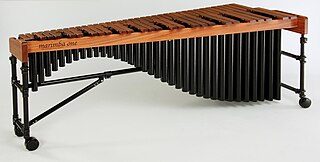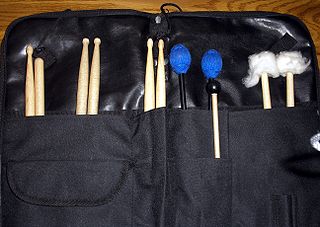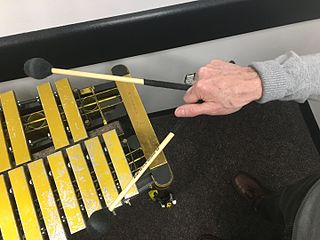
The marimba is a musical instrument in the percussion family that consists of wooden bars that are struck by mallets. Below each bar is a resonator pipe that amplifies particular harmonics of its sound. Compared to the xylophone, the marimba has a lower range. Typically, the bars of a marimba are arranged chromatically, like the keys of a piano. The marimba is a type of idiophone.

The vibraphone is a percussion instrument in the metallophone family. It consists of tuned metal bars and is typically played by using mallets to strike the bars. A person who plays the vibraphone is called a vibraphonist,vibraharpist, or vibist.

Timpani or kettledrums are musical instruments in the percussion family. A type of drum categorised as a hemispherical drum, they consist of a membrane called a head stretched over a large bowl traditionally made of copper. Thus timpani are an example of kettle drums, also known as vessel drums and semispherical drums, whose body is similar to a section of a sphere whose cut conforms the head. Most modern timpani are pedal timpani and can be tuned quickly and accurately to specific pitches by skilled players through the use of a movable foot-pedal. They are played by striking the head with a specialized drum stick called a timpani stick or timpani mallet. Timpani evolved from military drums to become a staple of the classical orchestra by the last third of the 18th century. Today, they are used in many types of ensembles, including concert bands, marching bands, orchestras, and even in some rock bands.

A drum roll is a technique used by percussionists to produce a sustained sound for the duration of a written note.
All drum figures are based upon three fundamental beats, technically called roll, single stroke, and flam...Sustentation is accomplished upon wind instruments by blowing into the instrument; it is accomplished upon the violin and the allied instruments by drawing the bow across the string; it is accomplished upon the drum and allied percussion instruments by the roll.
THE SNARE DRUM ROLL.
The roll consists of an even reiteration of beats sufficiently rapid to prohibit rhythmic analysis. To produce an impression of sustentation, these beats must be absolutely even both in power and in sequence. Uneven beats in a roll destroy the impression of sustentation. Evenness is then the primary quality to strive for in roll; speed is the secondary quality to strive for.
There are two possible ways of producing an absolutely even sequence: (1) hand alternation of single stroke and (2) hand alternation of double strokes...The snare drum roll is produced by hand alternation of double strokes.
The "open roll" is produced by [initially] slow hand alternation. Two strokes in each hand alternately are produced by wrist movement and each beat should follow its predecessor in clock-like precision.

A percussion mallet or beater is an object used to strike or beat a percussion instrument in order to produce its sound.
Stevens grip is a technique for playing keyboard percussion instruments with four mallets developed by Leigh Howard Stevens. While marimba performance with two, four, and even six mallets had been done for more than a century, Stevens developed this grip based on the Musser grip, looking to expanded musical possibilities. Stevens codified his grip and his approach to performance techniques developed during his studies at the Eastman School of Music in his 1979 book, Method of Movement for Marimba. In this book, Stevens explains that his grip is an evolution of the Musser grip, and it is sometimes called the Musser-Stevens grip.

The Burton grip is a method of holding two mallets in each hand in order to play a mallet percussion instrument, such as a marimba or a vibraphone, using four mallets at once. It was developed by jazz vibraphonist Gary Burton around the 1960s.

The marimbaphone is an obsolete tuned percussion instrument, developed by J. C. Deagan, Inc., of Chicago, Illinois, in the early 20th century.
Mitchell Thomas Peters was a principal timpanist and percussionist with the Los Angeles Philharmonic Orchestra. He composed well-known pieces for the marimba such as "Yellow After the Rain" and "Sea Refractions"; it is said that these works were composed because Peters felt that there was a lack of musically interesting material that would introduce his students to four-mallet marimba techniques.
Vida Chenoweth was a solo classical marimbist, an ethnomusicologist, and a linguist.
Robert Paterson is an American composer of contemporary classical music, as well as a conductor and percussionist. His catalog includes over 100 compositions. He has been called a "modern day master" and is primarily known for his colorful orchestral works, large body of chamber music and clear vocal writing in his operas, choral works, vocal chamber works and song cycles.

Linda Maxey is a celebrated concert marimbist virtuoso and was the first marimbist presented by Community Concerts, a division of Columbia Artists Management in New York that presented concerts to a network of subscription audiences whose pooled resources attracted leading performers and ensembles.
Clair Omar Musser (1901–1998) was a marimba virtuoso, a conductor and promoter of marimba orchestras, a composer, a teacher, a designer of keyboard percussion instruments, an inventor, and an engineer for Hughes Aircraft.

In percussion, grip refers to the manner in which the player holds the percussion mallet or mallets, whether drum sticks or other mallets.
Bob Becker is an American percussionist and composer known primarily as a founding member of the Nexus percussion ensemble, as well as a performer in the Steve Reich and Musicians ensemble. He primarily performs as a keyboard percussionist, but is also skilled in tabla and concert snare drumming. As a composer, Becker employs a multicultural approach by mixing the style of western military drumming with North Indian Hindustani idioms, such as raga scale patterns and tabla drumming. This fusion of compositional practices is the main focus of works like Lahara and Mudra. There are also traces of influence from the music of minimalists like Steve Reich, which can be attributed to Becker's experience with that composer's music.
The Fulcrum grip is a four-mallet grip for vibraphone and marimba developed by vibraphonist and educator Ed Saindon. The aim of the grip is to use varying fulcrum positions and finger technique to achieve the control, speed, and power of a two-mallet grip while being able to use all four mallets.
Stanley Sprenger Leonard is a timpanist, composer and educator who has been active in the percussion world for over seventy years. While Principal Timpanist of the Pittsburgh Symphony Orchestra for 38 years (1956-1994), he performed internationally with the symphony in concerts, television productions, and recordings." The Christian Science Monitor claimed, "...his performance of the solo part establishes him as perhaps the finest timpanist in the country." As a solo artist, he premiered several major new works for solo timpani and orchestra with the Pittsburgh Symphony Orchestra. In a review of "Celebrations—An Overture for Timpani and Orchestra," the Pittsburgh Post-Gazette said, "Leonard played it superbly, imparting a singing line to this most unvocal instrument." In 2010, he was inducted into the Percussive Arts Society Hall of Fame, where they summed up his musical contribution: "Leonard has left an indelible musical footprint for musicians, especially percussionists." He is currently resident timpanist, composer, was handbell director at Vanderbilt Presbyterian Church, Naples, Florida, and continues to compose and teach master classes.
Julia Hillbrick Gaines is an American percussionist and academic. As of 2021, she is the director of the School of Music at the University of Missouri in Columbia, Missouri. Gaines has performed as a soloist worldwide and released her first album, Tiger Dance in 2017. She was on the International Board of Directors of the Percussive Arts Society, eventually serving as Secretary. Gaines has performed with the Missouri Symphony, the Oklahoma City Philharmonic, the Fox Valley Symphony, and the Green Bay Symphony Orchestra. She has served as Associate Editor for Percussive Notes, a scholarly journal of the Percussive Arts Society and is currently Associate Editor of the Keyboard Percussion section.
John H. Beck is professor emeritus of percussion at the Eastman School of Music and was principal timpanist for the Rochester Philharmonic Orchestra from 1962 to 2002.









